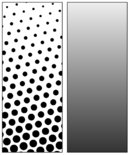Halftone
Halftone is the reprographic technique that simulates continuous-tone imagery through the use of dots, varying either in size or in spacing, thus generating a gradient-like effect. "Halftone" can also be used to refer specifically to the image that is produced by this process.[1]
Where continuous-tone imagery contains an infinite range of colors or greys, the halftone process reduces visual reproductions to an image that is printed with only one color of ink, in dots of differing size (pulse-width modulation) or spacing (frequency modulation) or both. This reproduction relies on a basic optical illusion: when the halftone dots are small, the human eye interprets the patterned areas as if they were smooth tones. At a microscopic level, developed black-and-white photographic film also consists of only two colors, and not an infinite range of continuous tones. For details, see film grain.
Just as color photography evolved with the addition of filters and film layers, color printing is made possible by repeating the halftone process for each subtractive color – most commonly using what is called the "CMYK color model". The semi-opaque property of ink allows halftone dots of different colors to create another optical effect, full-color imagery.
References
- ↑ Wikipedia_Halftoning
Chat rooms • What links here • Copyright info • Contact information • Category:Root
